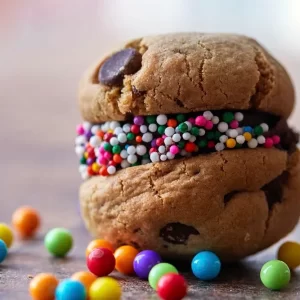Exploring the Tasty Journey of Ice Cream: From Ancient Origins to Global Sensations
Ice cream is more than just a dessert; it’s a cultural phenomenon. Its taste transports us to childhood memories, its variety sparks creativity, and its ubiquitous presence is synonymous with joy. And come on, who doesn’t love ice cream? But how much do you actually know about this creamy, dreamy treat? Buckle up; we’re about to go on a flavor-filled journey through the world of ice cream!
What Is Ice Cream, Anyway?
Let’s start with the basics. Ice cream is usually made from milk, cream, sweeteners, and flavorings. Sometimes, stabilizers or food coloring get thrown into the mix. You take all of these ingredients, mix ’em up, cool ’em down, and voila! Ice cream!
- Milk or Cream: This is the main ingredient and provides the creaminess.
- Sweeteners: Could be sugar, honey, or even sugar alternatives.
- Flavorings: Think vanilla, chocolate, fruits, or even wacky stuff like lavender.
The Cooling Process: We owe the magical transformation of these ingredients into ice cream to the cooling and churning process. This keeps ice crystals from forming, which would otherwise turn it into a block of ice. No one wants that!
Ice Cream vs. Everything Else
You might think anything cold and sweet could be labeled as ice cream, but oh boy, are you wrong! Here’s how to tell your gelatos from your sorbets:
- Gelato: Italian for ice cream, but made with more milk and less air, making it denser.
- Frozen Custard: Basically, ice cream on steroids. It’s richer due to the addition of egg yolks.
- Soft Serve: That swirly goodness you get from fast-food places; it’s just ice cream with more air.
- Dairy-Free Options: From almond milk to oat milk, there are options for lactose-intolerant and vegan folks.
- Froyo: Short for frozen yogurt, it’s made with yogurt instead of cream. Healthier, but let’s be real, it’s not ice cream.
- Sorbet and Sherbet: These are your fruit-based, dairy-free options. Refreshing, but again, not ice cream.
The Name Game
The term “ice cream” means different things depending on where you are in the world. In the United States, the government actually regulates what can be called “ice cream” based on things like the amount of cream used. If it doesn’t meet the criteria, you’ll find it labeled as “frozen dairy dessert.” Over in Italy and Argentina, however, one word covers all frozen treats.
The Incredible History of Ice Cream 🍨📜
Fasten your seatbelts; we’re time-traveling to dig into how this frozen delicacy came to be.
Early Beginnings
Persia: Yep, people were enjoying frozen desserts way back in 550 BC. They had things like faloodeh and sorbets, thanks to ice houses.
Roman Empire: First-century Roman cookbooks even had recipes that included sweet desserts sprinkled with snow.
Tang Dynasty: In China, they made a frozen treat with flour, camphor, and water buffalo milk.
Feudal Japan and the Aristocratic Ice
Ever heard of Kakigori? It’s like a Japanese snow cone, and it dates back to the Heian period. The aristocrats used to save ice blocks to enjoy this treat in the summer.
The Arab Influence
The first known text about the artificial creation of ice cream comes from the Arab historian Ibn Abi Usaybi’a in the 13th century. This guy got the knowledge from Ibn Bakhtawayhi, an author shrouded in mystery.
The Endothermic Effect
Here’s a cool science fact: ice cream production became a lot easier with the discovery of the endothermic effect. Adding salt to ice lowers its melting point, allowing the cream to freeze. A game-changer!
A Global Affair
South Asia: Kulfi Love
During the 16th century, the Mughal Empire in India used ice from the Hindu Kush mountains to make delicious frozen treats like kulfi, often called “traditional Indian ice cream.”
Europe: Where Myths Melt
Ice cream gets mistakenly credited to Marco Polo a lot. Some even say Catherine de’ Medici brought it to France. But guys, ice cream was in Europe way before these legends!
France: The Ice Cream Café Culture
By 1686, Italian Francesco dei Coltelli had opened an ice cream café in Paris. It was such a hit that in the next 50 years, 250 more cafés popped up. Viva la France!
England: Royal Cravings
The first mention of ice cream in England was in 1671. But the first English recipe didn’t surface until 1718 in Mary Eales’s cookbook. Later on, Domenico Negri, an Italian confectioner, set up shop in London and his ice creams became a sensation.
The Evolution of Making Ice Cream 🕰️
A Luxury of Yesteryears
- Early Days: Ice cream used to be a luxury, folks! Picture this: people would literally harvest ice from lakes and ponds during winter and stash it in straw-insulated holes or ice houses. Even big shots like George Washington and Thomas Jefferson were all about that ice-storage life.
The Ice Tycoons
- The Ice King: Frederic Tudor from Boston turned ice-harvesting into big business. This guy was shipping ice from New England to as far away as India!
The Dawn of Handmade Ice Cream
- The Pot-Freezer Method: Initially, ice cream was made by hand using this method. A large bowl was put inside a tub filled with ice and salt, and then churned by hand.
- French Flair: The French upped the game by using a sorbetière, basically a fancier, lidded pail with a handle.
Technological Ice Age ⚙️
Bye-Bye, Pot-Freezer
- The Hand-Cranked Churn: This nifty device made smoother ice cream quicker and pretty much sent the pot-freezer method into retirement. The first U.S. patent was issued to Nancy Johnson in 1843.
Mass Production and Refrigeration
- The Ice Cream Mogul: Jacob Fussell was the first guy to go big. He started manufacturing ice cream on a large scale back in 1851.
- Industrial Refrigeration: When Carl von Linde invented this in the 1870s, we no longer had to cut and store natural ice. It changed the game, and the modern ice cream industry was born!
DIY Ice Cream
- Modern Methods: Today, you can whip up some ice cream at home with an electric ice cream maker or even with liquid nitrogen. Or you can be like WWII fighter pilots who made ice cream at high altitudes by rigging cans to their planes. Talk about high stakes dessert!
The “Real” Ice Cream 🍨
FDA’s Definition
- According to the U.S., it’s got to have more than 10% milk fat, 6 to 10% milk solids, and other specifics for it to be officially called ice cream. So, yeah, it’s serious business!
Canada’s Take
- Our northern neighbors have their own rules, distinguishing between “Ice cream mix” and “Ice cream,” each having its unique set of regulations.
Calorie Alert! 🚨
- Even low-fat versions can be pretty high in calories due to the sugar content. So maybe think twice before you dive into that pint of No-Fat Vanilla Fudge.
Ice Cream Across the Globe 🌍
Sweet Diversity
- Australia & New Zealand: These guys are among the top ice cream consumers in the world.
- Asia: From China’s traditional flavors like red bean and black sesame to India’s exotic kulfi, Asia is no slacker in the ice cream game.
- Europe: Whether it’s Italian gelato or Spanish helado, Europe knows how to do ice cream right.
- Middle East: Iran has fālūde, a sorbet with noodles, while Syria has Booza, a stretchy ice cream.
Fun Facts
- The UK has a market worth £1.3 billion, and in the U.S., vanilla and chocolate take up 40% of the ice cream market share. Yeah, they’re classics for a reason.
What Makes Ice Cream, Ice Cream? 🤔
It’s All Science, Baby
- Ice cream is a colloidal system, meaning it has ice crystals, air bubbles, and fat globules all interacting to give you that creamy goodness.
Food Safety Concerns 🚫
- Emulsifiers like Soy lecithin and polysorbate are often used, but be aware, some studies suggest they might not be super great for you.
Ice Cream Trivia
- Cones: Mrs. A.B. Marshall’s 1888 cookery book was the first to endorse serving ice cream in cones. How cool is that?
And there you have it, folks! We’ve just time-traveled through the fascinating world of ice cream. Whether you’re a vanilla purist, a gelato aficionado, or an experimentalist reaching for that red bean flavor, we can all scream for ice cream! 🍦🎉
Stay tuned for more delicious stories. Till then, keep those scoops coming!



